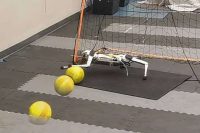The robot was developed by researchers at Harvard’s John A. Paulson School of Engineering and Applied Sciences (SEAS). The problem with robotic grippers is two-fold. Most of the effective ones are rigid, which makes it difficult to pick up irregular or fragile objects. They also require complex, embedded sensors and feedback control mechanisms and machine learning algorithms. There’s just a lot that can go wrong, and all to do something that even a toddler can do without much trouble. The tentacle gripper is designed to mimic the way jellyfish ensnare stunned prey. While one or two of the tentacles is insufficient to pick up even the smallest objects, having them all work together gives the robot plenty of redundancy and lifting power.
Unlike most graspers, the tentacles don’t need any sensing, planning, or feedback control. They’re pneumatically actuated — in the off state, they hang freely, allowing an operator to drape them over the target. When activated, the spindly rubber tubes contract. As you can see in the video, the tentacles wrap around the target securely as they move.
“Entanglement enables each highly compliant filament to conform locally with a target object leading to a secure but gentle topological grasp that is relatively independent of the details of the nature of the contact,” said L. Mahadevan, a professor of applied mathematics at SEAS. That’s a fancy way of saying the tentacles can pick up almost anything. The team tested the grasper on various objects, like the house plant seen above. It can also pick up soft fruits and vegetables without crushing them.
The SEAS team sees many potential applications for the tentacle robot, like agriculture, marine biology, and warehouse management. The research, funded by the National Science Foundation, has been published in the Proceedings of the National Academy of Sciences.



GIPHY App Key not set. Please check settings